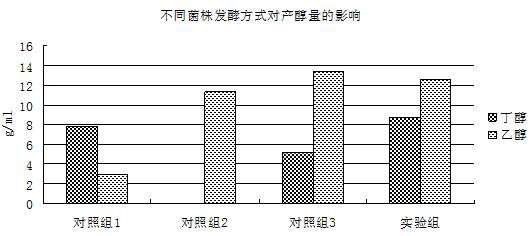A process for preparing and separating bio-butanol and bio-ethanol
A bio-ethanol and bio-butanol technology, applied in the field of fermentation, can solve environmental pollution and other problems, achieve good wall breaking effect, increase porosity and internal surface area, and increase industrial added value
- Summary
- Abstract
- Description
- Claims
- Application Information
AI Technical Summary
Problems solved by technology
Method used
Image
Examples
Embodiment 1
[0041] A process for preparing and separating bio-butanol and bio-ethanol, comprising the steps of:
[0042] First crush the corn stalks to less than 5cm, then put them under the conditions of pressure 1.5MPa and residence time 15min for steam explosion pretreatment, and then carry out blasting; pass the steam explosion treated corn stalks through a 50-mesh sieve, collect the sieve, Then add the undersize to 2 times the weight of water, heat to 60°C, stir at 100rpm for 90min under heat preservation conditions, then heat to 121°C, keep heat for 10min, and naturally cool to room temperature to obtain a culture solution;
[0043] Trichoderma konii seed liquid (density 1 × 10 8 cfu / mL) and Aspergillus niger seed solution (density 1×10 8 cfu / mL) mixed according to the volume ratio of 2:1, and then inoculated into the culture medium according to the inoculum amount of 6-8%, and cultivated for 96 hours. During the cultivation, the stirring speed was controlled at 100rpm, and the cul...
Embodiment 2
[0046] The method for producing bio-butanol and bio-ethanol by using corn stalks as the main raw material for fermentation comprises the following steps:
[0047] Firstly crush the corn stalks to less than 5cm, then place them under the conditions of pressure 2MPa and residence time 10min for steam explosion pretreatment, and then carry out blasting; pass the steam explosion treated corn stalks through a 50-mesh sieve, collect the sieved material, and then Add the undersieve to 1.5 times the weight of water, heat to 60°C, stir at 100rpm for 90min under heat preservation conditions, then heat to 121°C, keep heat for 10min, and naturally cool to room temperature to obtain a culture solution;
[0048] Trichoderma konii seed liquid (density 1 × 10 8 cfu / mL) and Aspergillus niger seed solution (density 1×10 8 cfu / mL) mixed according to the volume ratio of 3:2, and then inoculated into the culture medium according to the inoculum amount of 6-8%, and cultivated for 96 hours. During ...
Embodiment 3
[0051] The changes in the main components of corn stalks caused by blasting are shown in Table 1:
[0052] Table 1
[0053] index Before blasting after blasting Hemicellulose and Cellulose% 61.2 48.9 Lignin% 22.7 15.6 Xylooligosaccharide% 0 6.9 Cellooligosaccharides 0 3.1
[0054] Conclusion: Blasting caused the cell wall of straw to be destroyed, and some hemicellulose and cellulose were degraded and dissolved, which was beneficial to the subsequent enzymatic hydrolysis of cellulose by cellulase; the crystallinity and polymerization degree of cellulose decreased during the blasting pretreatment process, and hemicellulose passed It is degraded into xylose by hydrolysis and can be used as a carbon source for the strain.
PUM
 Login to View More
Login to View More Abstract
Description
Claims
Application Information
 Login to View More
Login to View More - R&D
- Intellectual Property
- Life Sciences
- Materials
- Tech Scout
- Unparalleled Data Quality
- Higher Quality Content
- 60% Fewer Hallucinations
Browse by: Latest US Patents, China's latest patents, Technical Efficacy Thesaurus, Application Domain, Technology Topic, Popular Technical Reports.
© 2025 PatSnap. All rights reserved.Legal|Privacy policy|Modern Slavery Act Transparency Statement|Sitemap|About US| Contact US: help@patsnap.com



